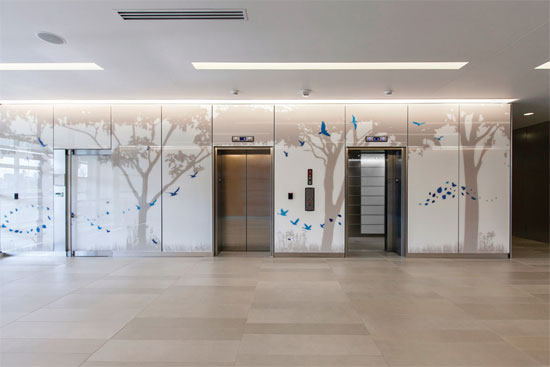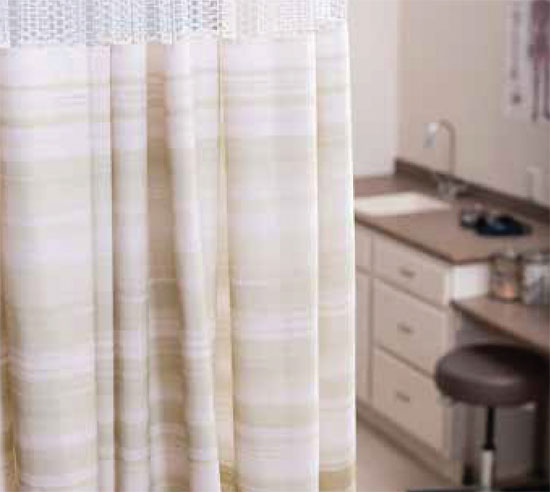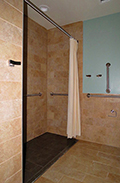Healing Environments: New Design Directions, New System Solutions
Performance Considerations
As we have seen, design elements in health care settings have the ability to enhance a space, create a more human atmosphere, and transform what can be a very intimidating and stressful setting into a warm, nurturing environment. But they must also comply with the many long- and short-term performance needs of healthcare environments. They need to be easy to clean and maintain to address sanitation and safety requirements. Where possible, they should help prevent the spread of bacteria and in so doing reduce the potential for hospital acquired infections. They should be durable, to withstand high volumes of people and their possessions, as well as hospital equipment like wheel chairs, gurneys, and carts. They should be eco-friendly, so as not to negatively impact indoor air quality or the health and safety of all who encounter them. And they should be built to last, not requiring frequent updates, repairs or replacement. In short, everything in a healthcare setting, whether a large hospital, a small medical office, or anything in between, must work together in order to achieve the best results not only for design but for performance too.
Artwork Materials
There are plenty of manufactured artistic materials and systems that have proven themselves around the world in public spaces of all kinds. Among the ways they address performance issues, the use of high-durability materials and finishes leads the list. Choices such as stainless steel, fused metal, bonded metal, laminated glass, and bonded quartz are just a few of the numerous durable, cleanable, and attractive materials that are possibilities. These surfaces and materials in turn become the basis for high performing solutions with virtually unlimited creative expression providing a robust visual vocabulary for walls, columns, elevator interiors and other interior applications. Further, they offer a sophisticated breadth of choices that can be tailored to meet the aesthetic and functional challenges of the full range of healthcare environments and other high-traffic public spaces. Artistic panels made of glass, for example, can vary by size, design, and application options, yet in all cases, the glass itself is easy to clean and maintain. And because the interlayer (artwork) is laminated between the lites of glass, it’s protected from outside impact and debris. Since most glass systems are pre-engineered across a wide range of mechanical details, designers can focus on their glass designs, knowing that typical installation, mounting, and trim details are addressed as part of the overall package.
Within this range of different materials, there are literally hundreds of material, finish, and pattern combinations to choose from. This gives healthcare designers extensive design and performance options that can be used to customize a look, match existing design and materials themes, and create high-impact, functional spaces. Beyond the pure materials, manufacturers offer smartly engineered systems that are efficient not only to install but also to maintain. This is due in part to attention to quality control in the manufacturing and fabrication of the finished systems and components. They also recognize and provide a range of environmentally-friendly options that architects and designers can feel good about specifying into healthcare environments. Aluminum-framed panels with a lightweight structural backing form the basis of most of these systems. Panel frames incorporate a panel attachment system mated to standard panel inserts drawn from manufacturers’ standard and custom offerings. Different panel styles provide different visual end results and support different material selections. Standardized system components such as corners, bases, and self-revealing mounting channels, eliminate the need for custom installation solutions and make it easy to resolve typical trim and installation details. Further, individual panels can usually be installed or removed independently, simplifying long-term maintenance or panel replacement.
If lighted panels are used, the best ones provide uniform light output, energy efficiency, and the performance of LED lighting, delivering up to 100,000 hours of worry-free illumination. Each panel is typically manufactured with a size-specific algorithm to ensure the look of even natural light, and eliminate hot spots, halos or dark areas. Such lighted panels are generally sold as a complete system that can be easily configured to meet project-specific needs. Standard packages include edge-lit LED panels with appropriate glass choices, a power source with dimming controls and wiring, and mounting cleat extrusions.

Photos courtesy of Forms+Surfaces
Artistic representation of nature can be used throughout healthcare settings, even in high use areas, due to their durable make-up.
Patient Area Cleanliness
Healthcare settings of course, attract people with diseases and other ailments. The ability of these settings to combat the transfer of those diseases often depends on the materials used as much as the cleaning and sanitation procedures of the facility. Antimicrobial treatments applied to materials that are commonly touched or used by people such as handrails and privacy curtains help facilities stay cleaner longer, and can, in certain cases, help prevent the spread or growth of bacteria. This is significant because of documented concerns about hospital acquired infections whereby patients have become exposed to bacteria and developed serious infections simply by being in a healthcare setting. Cleanliness is always important to fight this concern, but studies of specific materials and products have shown that some bacteria can be controlled by the antimicrobial characteristics of tested products. Even if antimicrobial action isn’t sought, cleanliness and ease of keeping surfaces clean certainly is.
As a corollary to the issues of décor and cleanliness, preservation of materials, meaning maintaining the appearance and functionality of the materials, also has an impact on the overall performance of those materials. For example, fabric items like patient area curtains are prone to all kinds of splatters and stains. The cost of removing those curtains for routine laundering can be significant over time when labor costs are accounted for along with lost revenue due to room closures. In response, some manufacturers provide fabrics that contain ingredients to make them permanently stain resistant reducing the need for laundering and adding to their long term use. With this fabric technology, liquids have been demonstrated to bead up and run off the fabric for continuous protection against stains. Some of these fabrics can be paired with an antimicrobial mesh that’s been tested and proven to permanently inhibit the growth of mold and mildew without releasing toxins into the environment (when laundered according to manufacturer’s instructions). They can also be specified to be flame retardant to address appropriate fire safety concerns.

Photos courtesy of Inpro
Fabrics used in healthcare settings can be specified to resist liquids, stains, and have antimicrobial properties that inhibit the growth of mold and mildew.
High Performance Glass Block Systems
We have discussed the design attributes of glass block in interior applications related to durability, clean-ability, and light enhancement. For exterior application in the building envelope, there are also glass block panels available that are hurricane, tornado, or blast resistant. This degree of protection has been sought after in situations where healthcare facilities need to remain resilient and operational during severe weather events or where security is a particular concern. As such, this type of glass block window system is ideal for facilities where safety and security is critical while requiring minimal maintenance.
Window systems using these types of high performing, damage resistant glass blocks are typically pre-fabricated panels that are factory assembled and designed to be easily installed at the job site to protect buildings and their inhabitants. The factory assembly helps to assure consistent quality and reduces on-site labor costs. These damage resistant window systems have been found to be extraordinarily versatile and are available in various sizes to work with the needs and constraints of a particular building. Some tornado-resistant glass block panels use laminated solid glass block with a continuous steel frame and grid. This approach provides the needed tornado protection while allowing people to see what is happening outside and letting daylight into the space. In accordance with FEMA 361, a number of these windows have been tested and passed several levels of air pressure tests including positive 309 psf and negative 413 psf. The 413 psf equates to a wind speed of over 400 mph. It is significant to note that the highest recorded wind speed on earth was 253 mph.
Among the characteristics of this type of high performance glass block system, effective protection against flying debris caused by tornado or hurricane-force winds is also readily provided. Hurricane-resistant glass block panels have been tested to meet the large missile impact tests referenced in the International Building Code and Dade County Approval Protocols making them approved for use in coastal areas even without shutters. Hurricane-resistant panels commonly consist of glass block framed by a 2-piece aluminum channel that can be mill finished, anodized, or powder coated. They can usually be ordered in custom sizes in 8” increments up to 4’ x 8’ (with 80 PSF Design Pressure Rating).
This type of protection also works equally as well for locations where blast resistance may be a concern. Many injuries to building occupants are caused by glass fragments sent flying through the air from the force of a blast. Unlike laminated flat glass, which will often crack and sometimes release fragments during a blast, no cracking or loss of glass has been reported in tests conducted on blast-resistant glass block panels.


Photos courtesy of Pittsburgh Corning Glass Block
Pre-fabricated assemblies of glass block with metal frames and a variety of clear or obscured glass can be specified to withstand the effects of tornados, hurricanes, or blasts.
Notice

www.forms-surfaces.com

www.inprocorp.com

www.pittsburghcorning.com

www.schluter.com









